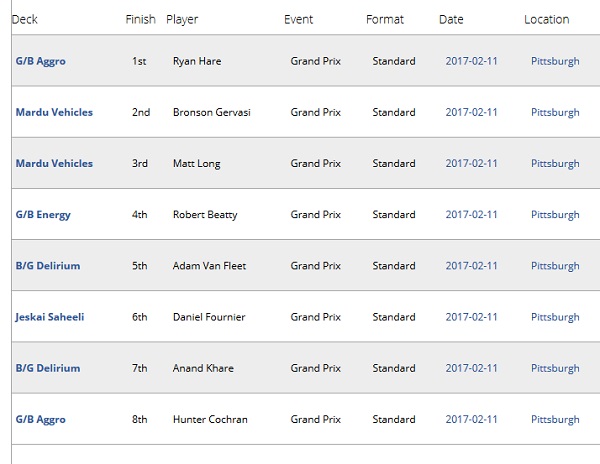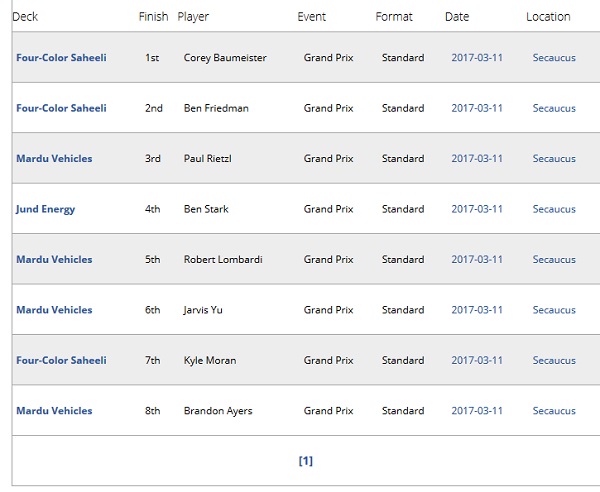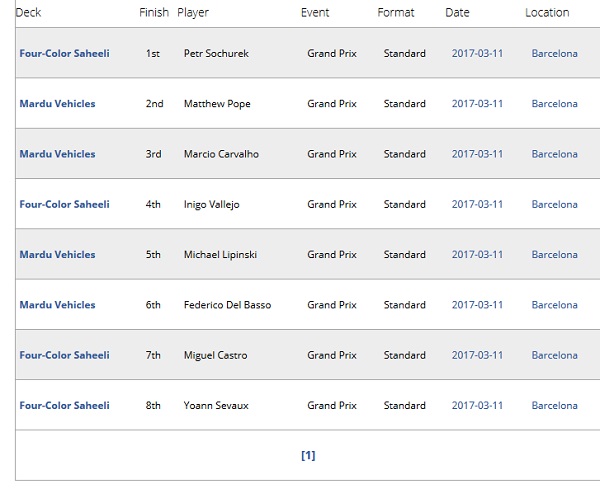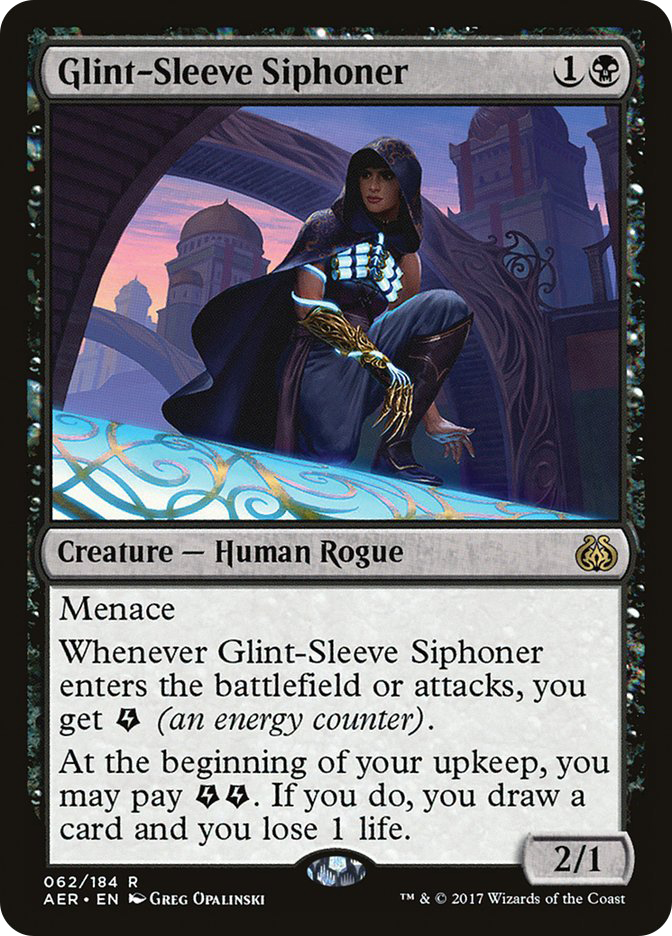We’re doing something a little different today. If you like it and find it helpful, be sure to say something so I know to do it again in the future.
One of the really cool things about Magic is the history that it creates. Not a history as long as the history of nations, of course, but one no less eventful for its brevity. As a format progresses, it feels like a story is being written by the Magic community. Decks rise and decks fall; individual cards are unbeatable one day and unplayable the next. Each tournament is a new chapter in the textbook, and each article written about them eyewitness testimony to the mood of the day.
And within the history of a format lies several smaller histories: the stories of the decks. It’s rare for a deck to undergo no changes from the time it breaks onto the scene until the end of its format, so rare as to be unheard-of, in fact. Players who stick with a deck for a while get to be part of that history. They were there when Card X fell out of favor; they remember when the land count increased. Their historical knowledge is an asset to them in the here-and-now, to be drawn on in adapting the deck to present conditions.
The flipside to this historical edge is that it is uniquely punishing to players looking to switch onto a deck late in a format. If you didn’t live Magic history, it can be very hard to piece together from lists alone. You might see a card in lists from when the deck first appeared, note that it quickly stopped seeing play, and reach the conclusion that it wasn’t very good. The next thing you know, everyone else on your deck is playing the card again and talking about how good it is in this new metagame. Whoops.
Today we’re going to trace the history of B/G Energy. We’ll look at the lists as they emerged; more importantly, we’ll look at the context they emerged in. We’ll look at the glory days and we’ll look at the dark ages. We’ll see cards fall in and out of favor, and hopefully, we’ll learn a thing or two about what makes the deck tick.
Enter Glint-Sleeve Siphoner
Let’s start at the beginning.
Creatures (25)
- 2 Kalitas, Traitor of Ghet
- 3 Tireless Tracker
- 2 Verdurous Gearhulk
- 4 Servant of the Conduit
- 4 Winding Constrictor
- 3 Rishkar, Peema Renegade
- 4 Glint-Sleeve Siphoner
- 3 Walking Ballista
Planeswalkers (2)
Lands (24)
Spells (9)

#SCGCOL was a strange tournament. Not only was it the first big Standard tournament with Aether Revolt, it was the first tournament since the banning of Smuggler’s Copter, Reflector Mage, and Emrakul, the Promised End. The predominant feeling at the time was that the new bans would affect the Standard metagame more than the new cards, with the sole exception of Felidar Guardian. But Stephen Dykman threw the common wisdom in all of our faces and took second place with the first-ever build of B/G Energy.
But before we dive into Stephen’s list, we need to look at the list he lost to in the finals:
Creatures (25)
- 4 Mindwrack Demon
- 2 Tireless Tracker
- 4 Grim Flayer
- 4 Verdurous Gearhulk
- 4 Winding Constrictor
- 3 Rishkar, Peema Renegade
- 4 Walking Ballista
Lands (23)
Spells (12)

The finals of #SCGCOL set the stage for a brutal Brothers’ War. Snake against Snake and Ballista against Ballista, the next few weeks would see constant fighting between B/G Delirium and B/G Energy for the hearts and minds of B/G players everywhere. In winning that first high-profile clash, B/G Delirium took a sizeable lead in the war and was considered by most to be the superior deck. That would change.
Now, let’s take a closer look at that first B/G Energy list. Raw, yes, but not nearly as raw as it could have been. Indeed, for being a Day 1 list, Stephen’s build was remarkably prescient. The biggest oddity was the two maindeck copies of Kalitas, Traitor of Ghet, a card that would not prove its worth in the weeks to follow. In the end, B/G Energy is more an aggressive deck than a controlling one and does not play enough removal to really capitalize on Kalitas.
The only energy payoff in this first list was Glint-Sleeve Siphoner, but what an energy payoff that card is. Siphoner absolutely dominates games and metagames where it gets to stick around and draw a few cards. Trading one-for-one with a removal spell is unfortunate but fine, as you still aren’t down a card. Sadly, that’s far from the worst that can happen.
The tension between Glint-Sleeve Siphoner and Walking Ballista would define the next few weeks. The more play that Ballista sees, the worse Glint-Sleeve Siphoner gets. A turn 2 Siphoner is never bad, as trading with a Walking Ballista is fine. The late-game Siphoner are what do you in, the ones that can just be eaten alive by a charged-up Ballista. With B/G Delirium playing a full set of Walking Ballista and Siphoners of its own, it’s no wonder that it took an early lead in the B/G civil war.
Fast forward a week to #SCGRICH. B/G Delirium was by far the more popular B/G deck, but B/G Energy still managed to place a pilot into the Top 8.
Creatures (24)
- 1 Kalitas, Traitor of Ghet
- 3 Tireless Tracker
- 2 Verdurous Gearhulk
- 2 Servant of the Conduit
- 4 Winding Constrictor
- 3 Rishkar, Peema Renegade
- 4 Glint-Sleeve Siphoner
- 2 Gifted Aetherborn
- 3 Walking Ballista
Planeswalkers (2)
Lands (24)
Spells (10)

Only one week forward from Stephen’s list, and things have already progressed considerably. Kalitas is on its way out, and we see the first inclusion of eventual mainstay Blossoming Defense. But what I want to focus on here are the two copies of Gifted Aetherborn. Deathtouch was key in the B/G mirrors. Every B/G deck was capable of presenting very large threats thanks to Winding Constrictor, threats that Grasp of Darkness could no longer touch and, in the case of Verdurous Gearhulk, threats that Fatal Push was also useless against. Including sources of deathtouch aside from Hissing Quagmire was a nod to the mirror, and we’ll see Gifted Aetherborn again.
It’s important to note that including a nod to the mirror was super-reasonable in this time period. The format was looking to be dominated by B/G decks. Aether Revolt Standard was not settled yet, but if you polled a random Magic player, odds are they would have told you that some B/G deck was the best. Sadly, that would change.
One last schism to mention before we move on to days where B/G did not rule the streets: mine.
Creatures (25)
- 4 Catacomb Sifter
- 3 Duskwatch Recruiter
- 4 Verdurous Gearhulk
- 3 Servant of the Conduit
- 4 Winding Constrictor
- 3 Rishkar, Peema Renegade
- 4 Walking Ballista
Planeswalkers (3)
Lands (24)
Spells (8)

Unwilling to play Glint-Sleeve Siphoner into a field of Walking Ballista, I piloted B/G Energy without the energy to reasonable success. That success speaks to how modular the shell of the deck is: B/G Energy has no uncuttables. Sure, Winding Constrictor will never leave the maindeck, but you sideboard it out sometimes against heavy control decks where a large battlefield presence is a liability. Also, note the zero copies of Tireless Tracker in the entire 75. Tireless Tracker is a strange one in B/G Energy, a three-drop that’s more of a four-drop, a card that wants 26 or more lands in a deck that only plays 24. Powerful and strong, but not irreplaceable.
Hissing While the World Meows and Vrooms
All in all, the first couple of weeks of Aether Revolt Standard were a good time to be a B/G player. And then came the Pro Tour. The story of Pro Tour Aether Revolt was Mardu Vehicles. Not only did it win the tournament, it landed a full six of the Top 8 slots. And no, B/G was not either of the non-Mardu slots.
Still, things could have been worse. A quick look at the metagame breakdown shows that B/G Energy (known to Wizards of the Coast as “Black-Green Constrictor”) had a healthy meta-share and a reasonable Day 2 conversion rate. And in the days to follow, the deck would gain a champion.
Creatures (27)
- 3 Tireless Tracker
- 2 Gonti, Lord of Luxury
- 4 Verdurous Gearhulk
- 4 Servant of the Conduit
- 4 Winding Constrictor
- 2 Rishkar, Peema Renegade
- 4 Glint-Sleeve Siphoner
- 4 Walking Ballista
Lands (24)
Spells (9)

Brad Nelson took this list to thirteenth place at Pro Tour Aether Revolt and achieved an excellent 8-2 record in Constructed play with it. His list was a cleaned-up version of the B/G Energy lists we had seen so far. He ran four of all the best cards: Walking Ballista, Winding Constrictor, Verdurous Gearhulk. He innovated Gonti, Lord of Luxury as the mirror-breaker to end all mirror-breakers, and Gonti would go on to be a staple in the archetype. Gonti does everything B/G Energy wants to do in B/G mirrors. They serve as a removal spell for huge creatures and further the deck’s ability to grind out the opposition. In non-B/G matchups, Gonti had a place as Fumigate insulation of sorts, a way to commit further to the battlefield in the face of a possible sweeper, hopefully tagging a Gideon, Ally of Zendikar on the way.
As encouraging as Brad’s performance was to B/G Energy in the face of the Mardu domination, as helpful as his cleaned-up and tuned list was, his Pro Tour performance was not as important to the history of B/G Energy as the fact that he wasn’t quiet about it. His writing for the next few weeks centered on B/G Energy, and he sold the deck like none other. Maybe that explains what happened at Grand Prix Pittsburgh.

Grand Prix Pittsburgh was the first post-Pro Tour Standard tournament. Somehow, in the face of a Standard that looked to be dominated by Mardu Vehicles, B/G came out on top. It didn’t just come out on top; it dominated. Even in the midst of outside strife, the B/G decks didn’t stop their internal war. B/G Delirium was for once the less popular choice, but B/G no-Energy beat out B/G Energy.
Creatures (25)
- 2 Sylvan Advocate
- 2 Tireless Tracker
- 2 Gonti, Lord of Luxury
- 4 Verdurous Gearhulk
- 4 Winding Constrictor
- 3 Rishkar, Peema Renegade
- 4 Gifted Aetherborn
- 4 Walking Ballista
Lands (24)
Spells (11)

Again, this result made sense. Glint-Sleeve Siphoner was still the major energy payoff, and Glint-Sleeve Siphoner is a liability in a field chock-full of Walking Ballista. Instead, B/G no-Energy played less vulnerable two-drops, among them Gifted Aetherborn for its mirror-winning power. The one true B/G Energy to deck to emerge looked a little different.
Creatures (25)
- 3 Verdurous Gearhulk
- 3 Longtusk Cub
- 4 Greenbelt Rampager
- 4 Winding Constrictor
- 3 Rishkar, Peema Renegade
- 4 Glint-Sleeve Siphoner
- 4 Walking Ballista
Planeswalkers (4)
Lands (20)
Spells (11)

If Glint-Sleeve Siphoner isn’t enough on its own, maybe Longtusk Cub and Greenbelt Rampager can make the energy subtheme worth it. Robert Beatty’s list is the closest we’ve seen yet to current-day B/G Energy lists, the first to include Attune with Aether and demonstrate a clear desire for the protection of Blossoming Defense.
B/G ruled the day at Grand Prix Pittsburgh, but that would be the last time the deck would see such success. In a world of Mardu Vehicles, B/G Energy could hold its own. But now we enter the dark ages.


Two Grand Prix tournaments, two continents, two Top 8s. Sixteen players, three different decks, and none of them B/G Energy. This weekend marked the rise of Four-Color Saheeli, and that deck’s rise began the fall of B/G strategies. A bright day in one history, a tragic day in another.
I know I said none of those sixteen decks were B/G Energy, but that’s not quite true.
Creatures (27)
- 3 Tireless Tracker
- 2 Verdurous Gearhulk
- 4 Longtusk Cub
- 4 Scrapheap Scrounger
- 4 Greenbelt Rampager
- 4 Winding Constrictor
- 2 Rishkar, Peema Renegade
- 4 Walking Ballista
Lands (21)
Spells (12)

We can forgive Ben Stark the red splash, as his list was the only bright spot for B/G Energy that weekend. Ben’s list is truly a B/G Energy list splashing red solely for Unlicensed Disintegration. Gone are the Glint-Sleeve Siphoners that once front-lined black energy strategies; in their place is a whole mess of aggression.
Four-Color Saheeli forced B/G Energy to be low to the ground to compete. Threats had to land early, and they had to hit hard. Longtusk Cub fit the bill nicely, as did Greenbelt Rampager. Still, B/G Energy was relegated to rogue strategy status for the next while in Standard, no longer the Tier 1 menace it had once been. Ben’s list proved that the strategy could still win, but times were hard.
Creatures (26)
- 3 Verdurous Gearhulk
- 4 Longtusk Cub
- 4 Greenbelt Rampager
- 4 Winding Constrictor
- 3 Rishkar, Peema Renegade
- 4 Glint-Sleeve Siphoner
- 4 Walking Ballista
Lands (21)
Spells (13)

The next lot of Grand Prix tournaments was more of the same: Four-Color Saheeli and Mardu Vehicles vying for the top position in the format, B/G Energy left in the dust. The above list is one of the few successful B/G lists from this time period, and we see again the emphasis on early threats. Rafael’s deck plays a whopping eight threats that cost more than two mana, alongside a full twenty creatures that can be cast on or before the second turn. The contortions that Four-Color Saheeli forced upon the deck cannot be overstated.
Amonkhet and Aetherworks Marvel
There was a month or so after Four-Color Saheeli’s rise to prominence when not a lot happened. Standard had no tournaments until Amonkhet and the format just kind of stewed in the spot the last batch of Grand Prix events left it. Then, all of a sudden, change galore. Amonkhet was released and Felidar Guardian was banned. Was it time for B/G to make a comeback?
Creatures (26)
- 4 Grim Flayer
- 4 Longtusk Cub
- 4 Greenbelt Rampager
- 4 Winding Constrictor
- 2 Rishkar, Peema Renegade
- 4 Glint-Sleeve Siphoner
- 4 Walking Ballista
Lands (16)
Spells (18)

#SCGATL was a triumph for Mardu Vehicles, but hope was not lost. B/G Energy had a few copies among the Top 16, including the above list. Blending Grim Flayer with Energy was a new idea, and one with some potential. The format was new and exciting, and it looked like B/G might make its comeback. And then, Pro Tour Amonkhet happened.
Somehow, the loss of Four-Color Saheeli only made things worse for B/G Energy. Fighting Four-Color Saheeli was possible, albeit difficult. Doing so warped the deck to an unbelievable degree, but at least it survived. In the face of Aetherworks Marvel, the deck didn’t even manage that.
Creatures (27)
- 4 Longtusk Cub
- 4 Greenbelt Rampager
- 4 Winding Constrictor
- 4 Rishkar, Peema Renegade
- 3 Glint-Sleeve Siphoner
- 4 Walking Ballista
- 4 Bone Picker
Lands (20)
Spells (13)

Pro Tour Amonkhet did include this beauty. Ken Yukuhiro played an all-out aggressive version of B/G Energy to the Top 8. Bone Picker and Heart of Kiran highlighted the differences between Ken’s build and all that came before. Maybe it was that aggressive potential that let him succeed with B/G Energy in a format where no one else did, but that success would not be duplicated.
In the weeks to follow, B/G Energy was nowhere to be seen. Grand Prix tournaments were dominated left and right by Aetherworks Marvel. The only build of Winding Constrictor to see any success looked like this:
Creatures (19)
- 1 Kalitas, Traitor of Ghet
- 3 Tireless Tracker
- 4 Grim Flayer
- 1 Verdurous Gearhulk
- 4 Winding Constrictor
- 2 Rishkar, Peema Renegade
- 4 Walking Ballista
Planeswalkers (6)
Lands (22)
Spells (13)

For a time, B/G Delirium had the edge in the Brothers’ War, but small mercy that, given how dominant Aetherworks Marvel still was. Maybe B/G Energy still had another trick to pull to make yet another comeback, but the world will never know. Just like that, it was over. Aetherworks Marvel, banned.
Current-Era B/G Energy
And here we are again, on the precipice of a new Standard format at #SCGINVI. Will it finally be time for B/G Energy’s long-awaited resurgence? Early online results are encouraging:
Creatures (24)
- 2 Tireless Tracker
- 3 Verdurous Gearhulk
- 4 Longtusk Cub
- 4 Winding Constrictor
- 3 Rishkar, Peema Renegade
- 4 Glint-Sleeve Siphoner
- 4 Walking Ballista
Planeswalkers (3)
Lands (21)
Spells (12)

B/G Energy is definitely one of the early decks to beat online. It has put up a number of 5-0 League finishes, and the lists are all similar to the one above. Now that all the unfair pressures of Four-Color Saheeli and Aetherworks Marvel have been lifted, the deck can finally raise its curve a bit and get back to playing Nissa, Voice of Zendikar. Longtusk Cub stays, the power of that card having been truly shown during the dark ages, but Greenbelt Rampager is long gone, a no-longer-needed relic.
For more on current-era B/G, check out Shaun McLaren’s Premium article from last week. Now that B/G is a force again, the Brothers’ War has once again flared up. Is Delirium the better strategy right now, or is it finally time for Longtusk Cub and friends to shine?
#SCGINVI will be history in the making. Successful B/G Energy pilots will be the ones who learn from the lessons of the deck’s troubled history and strike the right balance of mirror-hate, pure aggression, and battlefield-building for the current day. Like no other deck, the story of B/G Energy is the story of warping under pressure: outside pressure from unfair strategies, internal pressure from the need to beat other B/G strategies. Some of that pressure has now been alleviated, and being ahead of the curve in warping the deck back will be the difference between wins and losses.
Will B/G Energy return to the all-out aggression of Ken Yukuhiro? Will the current Magic Online results prove prophetic, or will Servant of the Conduit finally return? How far will B/G Energy pilots go to beat their B/G cousins? Is it time for the return of Gifted Aetherborn?
This next chapter should be good.





